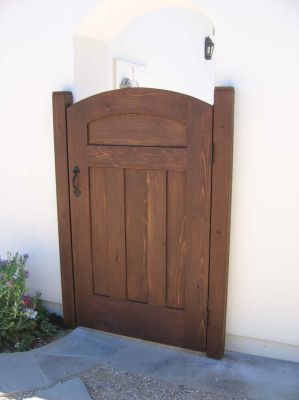Construction Methods for Wide Wooden Gates
A discussion about building cedar outdoor gates, covering dimensions and adhesive choices. February 5, 2007
Question
I have been making and installing cedar gates for a landscaping company for a while. Standard size has been 44" W X 6' H. I have made them from 1 1/2 cedar. They are made mortise/tenon construction with loose tenons for stile/rail joints. The company now wants wider gates 5' W X 6' H. I'm worried that the gate will sag over time. Should I go with thicker stock for the rails/stiles (2 1/4")? If so, should I use only solid thick stock, or can I laminate boards to make the thickness? The design will be similar to the photo.

Forum Responses
(Architectural Woodworking Forum)
From contributor L:
By a loose tenon, I assume you mean you mortise two holes and slip a flat dowel in both mortises. If you are using glue or epoxy, I don't see there being a problem. If you changed over to a real tenon instead of a loose tenon, then there would definitely be no problem.
From the original questioner:
Yes, they are flat dowels (loose tenons about 1/2" X 4" X 4" wider or narrower, depending on the rail). I use DAP Weldwood urea resin glue for the adhesive.
From contributor F:
Could you share where you are, climate, and cure time for the urea glue? Has the urea been all it should be, over time?
Form the original questioner:
My shop is located in Canoga Park (Los Angeles County, CA). Weather is typical San Fernando Valley weather: hot summers, coolish winters. Was just 118 near here a week ago. Humidity usually not so bad. I've used the DAP urea resin glue for about 3 years now. Never once had a problem for my uses. When it is really hot, the open time is not that great. I have to move fast if using it to glue faces on door stave-core stiles. Otherwise, it is easy to clean squeeze-out because it is water based.
From contributor G:
I make custom entry doors. Cope and stick with a loose tenon. If I make bigger (wider) garage doors, for instance, I try to make the stiles a little wider and the rails a little bit wider as the bearing surface of the shoulders on the rails have a lot to do with stopping the door sagging. You also need glue to keep things together. The sizes in your picture look fine.
From the original questioner:
Thanks a lot. I will increase the width of my rails.
From contributor J:
I worked in the marine industry for years and gained a great appreciation for epoxy glue. When you look at a rated strength comparison chart, epoxy has twice the strength of yellow glue. Use latex gloves (nerve damage as well as permanent skin cracking with years of constant use). Also, for the first ten minutes, you can wipe down and clean up with water. After that, acetone. The open time can be extended by keeping the mixture of catalyst and resin shallow (lined in plastic) in a large flat tray (cookie tray). But once it starts smoking, it's already kicked off. Also, the fumes of that smoke are toxic! As soon as it starts smoking, just pour water and let it sit a little, then discard. As with any glue, you can tint it by putting your stain or dry pigments right into the adhesive. Epoxy means the best strength commonly available! Okay - just my prejudice!
From the original questioner:
I use West System. Didn't know you could clean up with water (I thought lacquer thinner was best method). Only problem I have with epoxy is that it gets sucked into the grain (on end grain mostly) and keeps stain from penetrating that part. So, when I am making something to be stained, I stay away from using epoxy. Thanks for the tips.
From contributor E:
I've made a number of wide gates and in my experience, you must have diagonal bracing to keep the gate from sagging over time.
